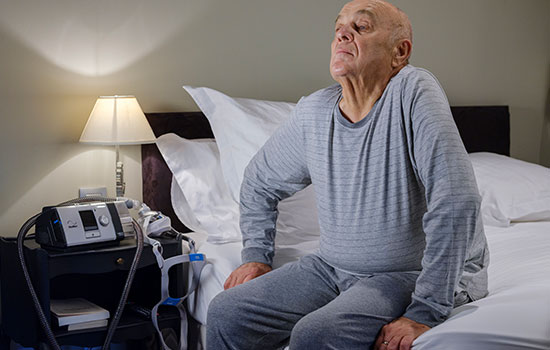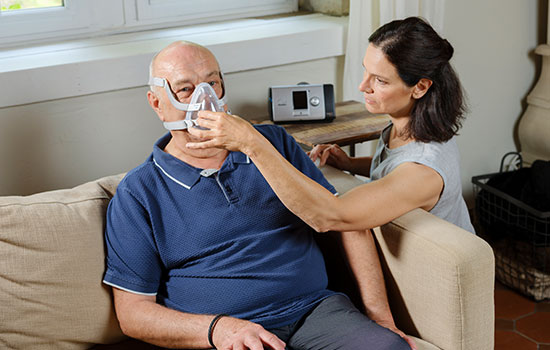COPD symptoms and treatment
What is COPD? Learn more about the causes, stages, diagnosis and treatment of chronic obstructive pulmonary disease.
What is chronic obstructive pulmonary disease (COPD)?
Chronic obstructive pulmonary disease (COPD) is an umbrella term for a group of progressive lung conditions that primarily includes chronic bronchitis and emphysema. The condition causes narrowing of the bronchial tubes in the lungs (sometimes called bronchi or airways) or damage to the air sacs in the lungs.
Symptoms of COPD include frequent coughing, increased shortness of breath, wheezing and tightness in the chest.1 While COPD is a progressive and (currently) incurable disease, with the right diagnosis and treatment you can do to manage your condition and breathe better. Treatment can include medication, oxygen therapy and non-invasive ventilation (NIV).
Over time, COPD makes it more difficult to breathe because the airways are partly blocked, restricting the flow of air in to and out of the lungs.
When this happens, less oxygen (O2) reaches the blood, and it becomes harder to get rid of the waste gas, carbon dioxide (CO2).
COPD is made up of 2 chronic conditions:
- Chronic bronchitis is a lasting inflammation of the airways that causes a persistent cough with mucus secretion.
- Emphysema causes irreversible damage to the air sacs (alveoli) in lung tissue, and results in shortness of breath.

What are the causes of COPD?
The main cause of COPD is tobacco smoking, with the prevalence of COPD appreciably higher for individuals who are or have been regular smokers compared to non-smokers.2
Other risk factors include exposure to air pollution and occupational exposure to dust and chemicals.3

What are the symptoms of COPD?
COPD usually takes years to develop. The earliest signs may be shortness of breath when climbing stairs or working around the house. Because breathing is such hard work, you may feel constantly tired. You may also have a regular cough, and build-up of mucus.
Air pollution, allergies, colds and influenza may cause COPD flare-ups, otherwise known as acute exacerbations.4 If you’re a smoker, you may also get frequent lung infections that can lead to pneumonia.
How is COPD diagnosed?
Your doctor will diagnose COPD (chronic obstructive pulmonary disease) based on your symptoms, medical history, a physical examination and a test of how you are breathing, also known as spirometry.2
During spirometry testing, the doctor will ask you to blow into a tube, and the test will record the different measurements of air volume and pressure as you breathe out. Some doctors may also recommend that you have an X-ray or CT scan, so they can have a closer look at your lungs.
In some cases, a blood test may be used to assess the levels of oxygen (O2) and carbon dioxide (CO2) in your blood.

How is COPD treated?
Although there is currently no cure for COPD, there are treatments available to relieve its symptoms, and slow down its long-term development.
Recommended treatments may include:
- Quitting smoking. If you’re a smoker, quitting is the best thing you can do to slow the progression of your COPD.5
- Medications. These can include various inhalers, steroids and antibiotics to help you manage your symptoms, and reduce the frequency and severity of flare ups (also known as acute exacerbations).5
- Pulmonary rehabilitation. A programme combining exercise with education about your disease will also help you cope with symptoms, and better manage your COPD.5
- Nutritional changes. Dietary changes can help some people with COPD feel better.5
- Oxygen therapy. For patients with inadequate levels of oxygen saturation in their blood (a condition known as hypoxia), oxygen therapy can help.5
- Non-invasive ventilation. Adding non-invasive ventilatory support to conventional therapy can reduce breathlessness, and improve respiratory rate and blood gas exchange.5 It can also improve quality of life.6
References:
- COPD symptoms and causes, Mayo Clinic, updated August 11, 2017, https://www.mayoclinic.org/diseases-conditions/copd/symptoms-causes/syc-20353679.
- Global Initiative for Chronic Obstructive Lung Disease (GOLD). “Global Strategy for the Diagnosis, Management and Prevention of COPD, 2015.” (accessed November 9, 2015) http://www.goldcopd.org/uploads/users/files/GOLD_Report_2015_Sept2.pdf
- Mannino DM and Buist AS. Global burden of COPD: risk factors, prevalence, and future trends. The Lancet 2007:370:765‐773.
- Eisner MD et al. An official American Thoracic Society public policy statement: Novel risk factors and the global burden of chronic obstructive pulmonary disease. Am J Respir Crit Care Med. 2010;182(5):693-718.
- McKenzie DK et al. The COPDX Plan: Australian and New Zealand Guidelines for the management of Chronic Obstructive Pulmonary Disease 2003. Med J Aust. 2003;178(6):S15-29.
- Köhnlein T et al. Non-invasive positive pressure ventilation for the treatment of severe, stable chronic obstructive pulmonary disease: a prospective, multicentre, randomised, controlled clinical trial. Lancet Resp Med 2014;2:698-705.







